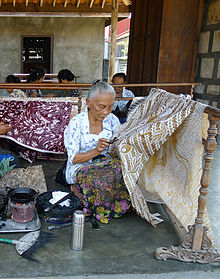| Indonesian Batik | |
|---|---|
 | |
| Country | Indonesia |
| Domains | Traditional craftsmanship, oral traditions and expressions, social practices, rituals and festive events |
| Reference | 00170 |
| Region | Asia and the Pacific |
| Inscription history | |
| Inscription | 2009 (4th session) |
| List | Representative |
| Written batik (batik tulis) and stamped batik (batik cap) | |
| Education and training in Indonesian Batik[a] | |
|---|---|
 | |
| Country | Indonesia |
| Domains | Traditional craftsmanship, oral traditions and expressions, social practices, rituals and festive events |
| Reference | 00318 |
| Region | Asia and the Pacific |
| Inscription history | |
| Inscription | 2009 (4th session) |
| List | Good Safeguarding Practices |
Batik plays multiple roles in the culture of Indonesia. The wax resist-dyeing technique has been used for centuries in Java, and has been adopted in varying forms in other parts of the country. Java is home to several batik museums.
On 2 October 2009, UNESCO inscribed written batik (batik tulis) and stamped batik (batik cap) as a Masterpiece of Oral and Intangible Heritage of Humanity from Indonesia.[1] Since then, Indonesia has celebrated a Batik Day (Hari Batik Nasional) annually on 2 October.[2] In the same year, UNESCO recognized education and training in Indonesian Batik as a Masterpiece of Oral and Intangible Heritage of Humanity.[3]
Cite error: There are <ref group=lower-alpha> tags or {{efn}} templates on this page, but the references will not show without a {{reflist|group=lower-alpha}} template or {{notelist}} template (see the help page).
- ^ "Indonesia Batik". UNESCO. Archived from the original on 8 December 2020. Retrieved 21 October 2019.
- ^ Cite error: The named reference
Shamasundari 2021was invoked but never defined (see the help page). - ^ "Education and training in Indonesian Batik intangible cultural heritage for elementary, junior, senior, vocational school and polytechnic students, in collaboration with the Batik Museum in Pekalongan". UNESCO. Archived from the original on 8 December 2020. Retrieved 5 February 2021.